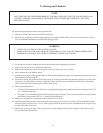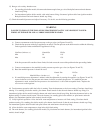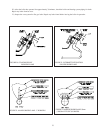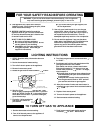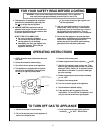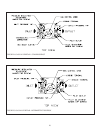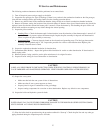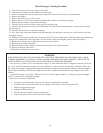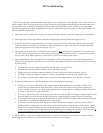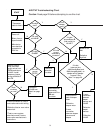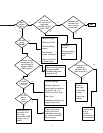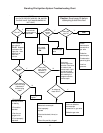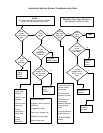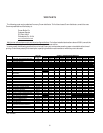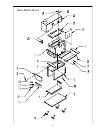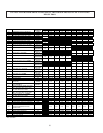
31
The following four pages contain troubleshooting charts for use in diagnosing control problems. To use these charts, go to
the box marked “Start” at the top of the chart on page 30 and follow the appropriate path though the chart until a box with a
list of possible causes is reached. If the problem is known to be within the ignition system, go directly to the appropriate
troubleshooting guide for the boiler (standing pilot on page 32 or intermittent ignition on page 33). In using these charts, the
following should be kept in mind:
1) These charts are only meant to be used by a professional heating technician as an aid in diagnosing control problems.
2) Where applicable, follow all precautions outlined in the appropriate lighting instructions on page 24 or 25.
3) In general, these charts assume that there are no loose or miswired electrical connections. Before using these charts,
inspect all electrical connections on the boiler to make sure that they are tight. Also, check the wiring on the boiler
against the appropriate wiring diagram in Figure 16 or 17.
4) The possible causes at the end of each branch in these charts are
not listed in order of likelihood. All controls on the
AWI and TWI are tested at least once in the manufacturing process and a defective control or component is generally
the least likely cause. Before replacing a component, try to rule out all other possible causes.
5) These troubleshooting charts assume that the vent damper is closed at the beginning of the troubleshooting process.
With the 120 volts applied to the boiler and no call for heat, the damper should go to the closed position. If it does not,
do the following:
• Confirm that 120 volts is applied to the boiler and that there is no call for heat.
• Make sure that the switch on the damper is in the “automatic” position.
• Unplug the harness from the damper and check for 24 volts across pin #1 (blue) and pin #4 (yellow).
• If voltage is present, the damper is defective or there is an obstruction in the path of the damper blade.
• If no voltage is present, there is either a loose connection in the damper harness or the L8148E is defective
6) If the charts indicate that the L8148E is defective, do the following before replacing it:
• Check for 24 volts across TV and Z. If no voltage is present, the transformer in the L8148E is defective. It is
possible that this transformer has been destroyed by a short circuit in the boiler wiring. Before replacing the
control, carefully inspect all low voltage wiring on the boiler for places where it is touching the frame of the boiler
or wiring on the other side of the transformer.
• If 24 volts is present across TV and Z, check for 24 volts between T and W. If no voltage is present, make sure that
the brass jumper is present between W and Z and that the screws holding this jumper in place are both tight.
• If not already done, temporarily replace the thermostat across TV and T with a jumper. If the boiler fires when this
is done, there is a problem with the thermostat or zone wiring.
• If 24 volts is present across T and W and the relay in the L8148E does not pull in, the relay in the L8148E is
probably defective. Inspect the coil of this relay for visible heat damage. If such damage is found, there is a good
chance that a second transformer is present in the thermostat or zone valve circuit, resulting in the application of
48 volts across the relay coil. In older buildings, this transformer may be hidden in a location far from the boiler. If
this second transformer exists, it must be found and removed before the L8148E is replaced.
7) When checking voltage across damper harness pins, be careful not to insert the meter probes into the pins. Doing so
may damage the pin, resulting in a loose connection when the harness is reconnected.
XII Troubleshooting
29



